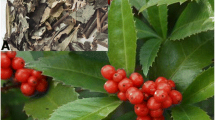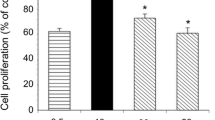Abstract
Isothiocyanates (ITCs) are molecules naturally present in many cruciferous vegetables (broccoli, black radish, daikon radish, and cauliflowers). Several studies suggest that cruciferous vegetable consumption may reduce cancer risk and slow the aging process. To investigate the effect of ITCs on cellular DNA damage, we evaluated the effects of two different ITCs [sulforaphane (SFN) and raphasatin (RPS)] on the biology of human mesenchymal stem cells (MSCs), which, in addition to their ability to differentiate into mesenchymal tissues, contribute to the homeostatic maintenance of many organs. The choice of SFN and RPS relies on two considerations: they are among the most popular cruciferous vegetables in the diet of western and eastern countries, respectively, and their bioactive properties may differ since they possess specific molecular moiety. Our investigation evidenced that MSCs incubated with low doses of SFN and RPS show reduced in vitro oxidative stress. Moreover, these cells are protected from oxidative damages induced by hydrogen peroxide, while no protection was evident following treatment with the UV ray of a double strand DNA damaging drug, such as doxorubicin. High concentrations of both ITCs induced cytotoxic effects in MSC cultures and further increased DNA damage induced by peroxides. In summary, our study suggests that ITCs, at low doses, may contribute to slowing the aging process related to oxidative DNA damage. Moreover, in cancer treatment, low doses of ITCs may be used as an adjuvant to reduce chemotherapy-induced oxidative stress, while high doses may synergize with anticancer drugs to promote cell DNA damage.


Similar content being viewed by others
References
Valgimigli L, Iori R (2009) Antioxidant and pro-oxidant capacities of ITCs. Environ Mol Mutagen 50:222–237
Fimognari C, Nusse M, Berti F, Iori R, Cantelli-Forti G, Hrelia P (2003) Sulforaphane modulates cell cycle and apoptosis in transformed and non-transformed human T lymphocytes. Ann N Y Acad Sci 1010:393–398
Scholl C, Eshelman BD, Barnes DM, Hanlon PR (2011) Raphasatin is a more potent inducer of the detoxification enzymes than its degradation products. J Food Sci 76:C504–C511
Ahn YH, Hwang Y, Liu H et al (2010) Electrophilic tuning of the chemoprotective natural product sulforaphane. Proc Natl Acad Sci USA 107:9590–9595
Barillari J, Iori R, Papi A et al (2008) Kaiware Daikon (Raphanus sativus L.) extract: a naturally multipotent chemopreventive agent. J Agric Food Chem 56:7823–7830
Conaway CC, Wang CX, Pittman B et al (2005) Phenethyl isothiocyanate and sulforaphane and their N-acetylcysteine conjugates inhibit malignant progression of lung adenomas induced by tobacco carcinogens in A/J mice. Cancer Res 65:8548–8557
Cornblatt BS, Ye L, Dinkova-Kostova AT et al (2007) Preclinical and clinical evaluation of sulforaphane for chemoprevention in the breast. Carcinogenesis 28:1485–1490
Dinkova-Kostova AT, Jenkins SN, Fahey JW et al (2006) Protection against UV-light-induced skin carcinogenesis in SKH-1 high-risk mice by sulforaphane-containing broccoli sprout extracts. Cancer Lett 240:243–252
Talalay P, Fahey JW, Healy ZR et al (2007) Sulforaphane mobilizes cellular defenses that protect skin against damage by UV radiation. Proc Natl Acad Sci USA 104:17500–17505
Zanichelli F, Capasso S, Cipollaro M et al (2012) Dose-dependent effects of R-sulforaphane isothiocyanate on the biology of human mesenchymal stem cells, at dietary amounts, it promotes cell proliferation and reduces senescence and apoptosis, while at anti-cancer drug doses, it has a cytotoxic effect. Age (Dordr) 34:281–293
Son TG, Camandola S, Mattson MP (2008) Hormetic dietary phytochemicals. NeuroMol Med 10:236–246
Beyer Nardi N, da Silva Meirelles L (2006) Mesenchymal stem cells: isolation, in vitro expansion and characterization. Handb Exp Pharmacol 174:249–282
Prockop DJ (1997) Marrow stromal cells as stem cells for nonhematopoietic tissues. Science 276:71–74
Sethe S, Scutt A, Stolzing A (2006) Aging of mesenchymal stem cells. Ageing Res Rev 5:91–116
Lombard DB, Chua KF, Mostoslavsky R, Franco S, Gostissa M, Alt FW (2005) DNA repair, genome stability, and aging. Cell 120:497–512
Roos WP, Kaina B (2006) DNA damage-induced cell death by apoptosis. Trends Mol Med 12:440–450
Fimognari C, Nusse M, Cesari R, Iori R, Cantelli-Forti G, Hrelia P (2002) Growth inhibition, cell-cycle arrest and apoptosis in human T-cell leukemia by the isothiocyanate sulforaphane. Carcinogenesis 23:581–586
Pochampally R (2008) Colony forming unit assays for MSCs. Methods Mol Biol 449:83–91
Sambrook J, Russell DW (2001) Molecular cloning: a laboratory manual. CSHL Press, Cold Spring Harbor
Galderisi U, Di Bernardo G, Cipollaro M et al (1999) Induction of apoptosis and differentiation in neuroblastoma and astrocytoma cells by the overexpression of Bin1, a novel Myc interacting protein. J Cell Biochem 74:313–322
Conaway CC, Getahun SM, Liebes LL et al (2000) Disposition of glucosinolates and sulforaphane in humans after ingestion of steamed and fresh broccoli. Nutr Cancer 38:168–178
Hanlon N, Coldham N, Gielbert A, Sauer MJ, Ioannides C (2009) Repeated intake of broccoli does not lead to higher plasma levels of sulforaphane in human volunteers. Cancer Lett 284:15–20
Johnson IT (2002) Glucosinolates: bioavailability and importance to health. Int J Vitam Nutr Res 72:26–31
Mi L, Xiao Z, Hood BL et al (2008) Covalent binding to tubulin by isothiocyanates. A mechanism of cell growth arrest and apoptosis. J Biol Chem 283:22136–22146
Montaut S, Barillari J, Iori R, Rollin P (2010) Glucoraphasatin: chemistry, occurrence, and biological properties. Phytochemistry 71:6–12
Nitiss JL (2002) DNA topoisomerases in cancer chemotherapy: using enzymes to generate selective DNA damage. Curr Opin Investig Drugs 3:1512–1516
Hoeijmakers JH (2001) Genome maintenance mechanisms for preventing cancer. Nature 411:366–374
Khanna KK, Jackson SP (2001) DNA double-strand breaks: signaling, repair and the cancer connection. Nat Genet 27:247–254
Ronen A, Glickman BW (2001) Human DNA repair genes. Environ Mol Mutagen 37:241–283
Sharpless NE, DePinho RA (2007) How stem cells age and why this makes us grow old. Nat Rev Mol Cell Biol 8:703–713
Galderisi U, Cipollaro M, Giordano A (2006) Stem cells and brain cancer. Cell Death Differ 13:5–11
Verhagen H, Coolen S, Duchateau G, Hamer M, Kyle J, Rechner A (2004) Assessment of the efficacy of functional food ingredients-introducing the concept “kinetics of biomarkers”. Mutat Res 551:65–78
Panis C, Herrera AC, Victorino VJ et al (2012) Oxidative stress and hematological profiles of advanced breast cancer patients subjected to paclitaxel or doxorubicin chemotherapy. Breast Cancer Res Treat 133:89–97
Author information
Authors and Affiliations
Corresponding author
Additional information
Fulvia Zanichelli and Stefania Capasso contributed equally to the research.
Electronic supplementary material
Below is the link to the electronic supplementary material.
Rights and permissions
About this article
Cite this article
Zanichelli, F., Capasso, S., Di Bernardo, G. et al. Low concentrations of isothiocyanates protect mesenchymal stem cells from oxidative injuries, while high concentrations exacerbate DNA damage. Apoptosis 17, 964–974 (2012). https://doi.org/10.1007/s10495-012-0740-3
Published:
Issue Date:
DOI: https://doi.org/10.1007/s10495-012-0740-3




